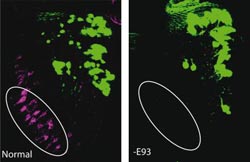Few genes control neuronal function

The magenta-colored structures are nerve cells that use odorant receptor 47b, which senses pheromones. Expression of this receptor is controlled by the transcription factor E93. When E93 is removed, the neurons lose their ability to fulfill their task do detect pheromones, as evidenced by the deactivation of the fluorescent proteins (image to the right). The glowing, green cells, that use olfactory receptor 92a, are not affected because they are controlled by other transcription factors. Credit: Mattias Alenius<br>
“Knowledge about the mechanisms that diversify neurons and keep them diverse is necessary in order to cultivate and replace nerve cells in the future,” says Mattias Alenius, Assistant Professor of Neuroscience, who has published his research breakthrough in the current issue of the journal PLoS Biology.
Alenius and his research team at the Department of Experimental and Clinical Medicine seek the answer to this pivotal question from a smaller perspective: the fruit fly's olfactory system.
The humble fly's olfactory system consists of 1200 olfactory neurons (humans have six million) divided into 34 groups. Each group responds to a particular set of odours, since all the neurons of the group use only one of the olfactory receptors present in the fly's antennas. Together, the receptors provide the fly with the ability to distinguish between thousands of odours: one olfactory receptor – one neuron group, simple yet complex.
Alenius and his colleagues are the first to go through all of the fruit fly's 753 gene regulatory genes, called transcription factors. They have identified a set of seven that, in different combinations, are required to create each of the 34 neuron groups in the antenna. A surprising finding is that most transcription factors perform two tasks simultaneously: they can activate odorant receptors' expression; while at the same time turning off others in the same cell.
Alenius explains, “This is one of the many tricks that are useful to know for the future if you want to make and cultivate each of the many thousands of nerve cell groups that make up our brains.”
Article: Combinatorial activation and repression by seven transcriptor factors specify Drosophila odorant receptor expression by S Jafari, L Alkhori, A Scheffler, A Brochtrup, T Hummel and M Alenius. PLoS Biology, 10:3, March 2012.
Media Contact
More Information:
http://www.liu.seAll latest news from the category: Life Sciences and Chemistry
Articles and reports from the Life Sciences and chemistry area deal with applied and basic research into modern biology, chemistry and human medicine.
Valuable information can be found on a range of life sciences fields including bacteriology, biochemistry, bionics, bioinformatics, biophysics, biotechnology, genetics, geobotany, human biology, marine biology, microbiology, molecular biology, cellular biology, zoology, bioinorganic chemistry, microchemistry and environmental chemistry.
Newest articles

A universal framework for spatial biology
SpatialData is a freely accessible tool to unify and integrate data from different omics technologies accounting for spatial information, which can provide holistic insights into health and disease. Biological processes…

How complex biological processes arise
A $20 million grant from the U.S. National Science Foundation (NSF) will support the establishment and operation of the National Synthesis Center for Emergence in the Molecular and Cellular Sciences (NCEMS) at…

Airborne single-photon lidar system achieves high-resolution 3D imaging
Compact, low-power system opens doors for photon-efficient drone and satellite-based environmental monitoring and mapping. Researchers have developed a compact and lightweight single-photon airborne lidar system that can acquire high-resolution 3D…





















